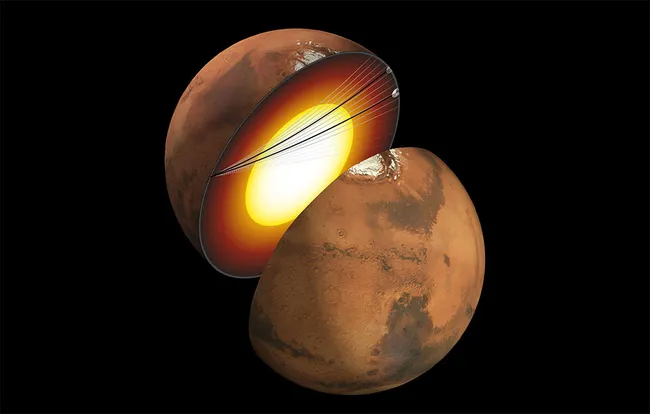Mars, our neighbor, is still full of mysteries and NASA missions have revealed some of them lately. Recent findings from NASA missions have shown that Mars’s spin is accelerating. This article explains more about these findings.
The Spining Planet
One of the most intriguing revelations comes from NASA’s InSight Mars Lander, which operated on the planet’s surface for four years before running out of power in December 2022. Data collected by InSight’s Rotation and Interior Structure Experiment (RISE) has shown that Mars’ rotation is actually speeding up.
Over the course of the mission, scientists used NASA’s Deep Space Network to track InSight’s position as it rotated with Mars. By measuring changes in radio signals bounced back from the lander, the team discovered that Mars’ rotation is accelerating by about 4 milliarcseconds per year. This translates to a shortening of the Martian day by a tiny fraction of a millisecond annually.
While this change may seem minuscule, it represents a significant finding in planetary science. The cause of Mars’ mysterious spin acceleration remains unclear, but scientists have proposed several potential explanations:
- Changes in Mars’ deep interior
- Long-term trends in atmospheric circulation
- Ice accumulation at the polar caps
- Post-glacial rebound, where landmasses rise after being freed from ice cover
Inside the Martian Core

The RISE experiment not only found Mars’ mysterious spin acceleration but also gave us a sneak peek into the planet’s internal structure. By measuring the wobble of the planet caused by the sloshing of its liquid core, scientists have updated their knowledge of Mars’ core size and composition.
The new data says Mars’ core is bigger than we thought, with a radius of about 1,140 miles (1,830 km). The liquid core is less dense than expected, with more of the lighter elements, especially sulfur. In fact, the Martian core may have up to 20% more sulfur than we previously thought, which has big implications for how we think the planet formed and evolved.
Atoko Point: A Geological Anomaly
While InSight has been digging into Mars’ interior, Perseverance has found its mysteries on the surface. In the Mount Washburn area of Jezero Crater, Perseverance stumbled upon a strange white rock that stood out big time from the surroundings. Nicknamed “Atoko Point,” this 14-inch tall boulder has scientists scratching their heads about its composition and origin.
Analysis using Perseverance’s SuperCam and Mastcam-Z instruments reveals that Atoko Point is composed primarily of pyroxene and feldspar, minerals commonly found in meteorites and lava flows. The rock’s distinct appearance and composition have led to various theories about its origin:
- Some researchers speculate that Atoko Point may have formed from minerals produced in a subsurface magma body, possibly now exposed on the crater rim.
- Others suggest it might have originated far beyond Jezero Crater and been transported to its current location by ancient Martian waterways.
Mars and Beyond
These results show Mars is a dynamic place and we need to keep exploring. The spinning, core, and surface features all help us understand the past, present, and future of the Red Planet.
As we solve these Martian puzzles we get to learn about our neighbour and also about planetary formation and evolution in general. The InSight and Perseverance results open the door for future missions and get us closer to answering the question of past or present life on Mars.
More to come, more questions, and more to explore. As we dig deeper into Mars’ spin and weirdness we get closer to the secrets of the solar system and maybe our own planet’s past and future.
